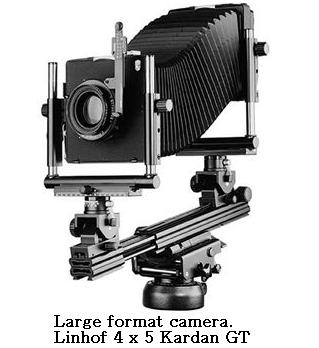Types of Cameras
3) Large format cameras:
These are larger and heavier cameras which generally need the use of a tripod. These are the oldest cameras. As a matter of fact, the first cameras all had a large format.
It takes longer to take a picture because we need to prepare the camera, make some adjustments, place the film roll, close the shutter, etc. Each picture carries a process longer and more complicated than any of the other cameras we have mentioned so far. The different sizes of large format cameras are:
9 x 12cm (4x 5p), 13 x 18cm (5x 7p), 20 x 25cm (8x 10p).

The advantages of these cameras are:
- Larger negative, thus, there is more detail.
- More definition.
- There is no "parallel" problem: what we see is what we will photograph.
- The viewing window is large. This means we can control whether the picture is in focus, or not.
- We can develop each picture individually.
- We can correct perspective, which is widely used when photographing architecture.
- We can differentiate its focus.
- Nowadays, there are digital chassis.
The disadvantages of these cameras are:
- They are heavy and need a tripod.
- Generally, to be able to see the image, we need to put a black cover over our heads and the camera.
- As we look at the image in the viewing window, it appears inverted from right to left and upside-down.
- These cameras are more expensive than the previous ones.
- Both film rolls and developing are more expensive.

